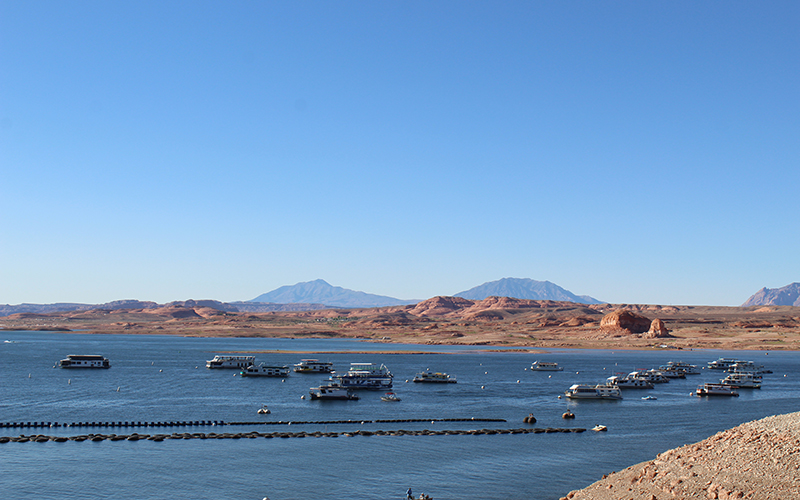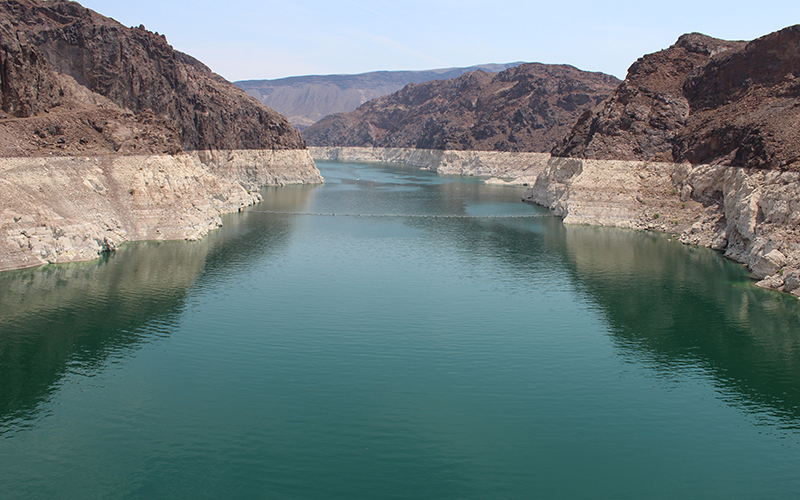
Anchored houseboats gather at Hall’s Crossing Marina on Lake Powell in southern Utah. (Photo by Luke Runyon/KUNC)
Emergency water releases from reservoirs upstream of Lake Powell are underway to preserve the ability of the nation’s second-largest reservoir to generate hydroelectric power.
The Bureau of Reclamation started releasing additional water Thursday from Flaming Gorge Reservoir in Wyoming. Additional water releases from Blue Mesa Rreservoir in Colorado and Navajo Reservoir in New Mexico are planned for later this year. Emergency releases could last until at least December.
Lake Powell is projected to hit a record low in July. It’s situated on the Colorado River, a drinking and irrigation water source for more than 40 million people in the Southwest. Inflows to the enormous reservoir were the third lowest on record in 2021. That followed a meager runoff in 2020.
The releases are meant to maintain some level of hydroelectric power at Lake Powell’s dam, which is under increasing threat due its low level. Glen Canyon Dam’s minimum hydropower level is at 3,490 feet above sea level. It’s currently at 3,557 feet and is forecast to drop to 3,515 feet by the end of April 2022.
Hydropower production might become unfeasible at elevations above 3,490 feet because of turbine cavitation, when small air bubbles form and damage the generators’ inner workings.
Releases from Flaming Gorge Dam will increase by 50 cubic feet per second every day until July 23. Daily releases from Flaming Gorge will rise from 860 cubic feet per second to 1,310 cubic feet per second, “in response to basin-wide drought and storage concerns at Lake Powell,” reclamation staff told stakeholders this week.
The Upper Basin states of Colorado, Wyoming, New Mexico and Utah agreed to possible federal intervention, under emergency circumstances, to boost Lake Powell’s levels in the 2019 Drought Contingency Plan. This is the first time this portion of the plan has been put into action.
“We are facing unprecedented dry conditions in the Colorado River Basin. More details about conditions as well as planning efforts are forthcoming,” said Rebecca Mitchell, Upper Colorado River commissioner for the state of Colorado. “What we do know is that the Upper Basin Drought Contingency Plan calls for increased coordination and planning in situations like this. And those agreements call for the Bureau of Reclamation to closely consult with the Upper Basin States, including Colorado. It has never been more critical to work together.”
A federal shortage declaration in the river’s lower basin is expected next month due to record low levels at Lake Powell’s downstream sister reservoir, Lake Mead. The two are managed jointly by guidelines agreed to in 2007.
This story is part of ongoing coverage of the Colorado River, produced by KUNC and supported by the Walton Family Foundation.
